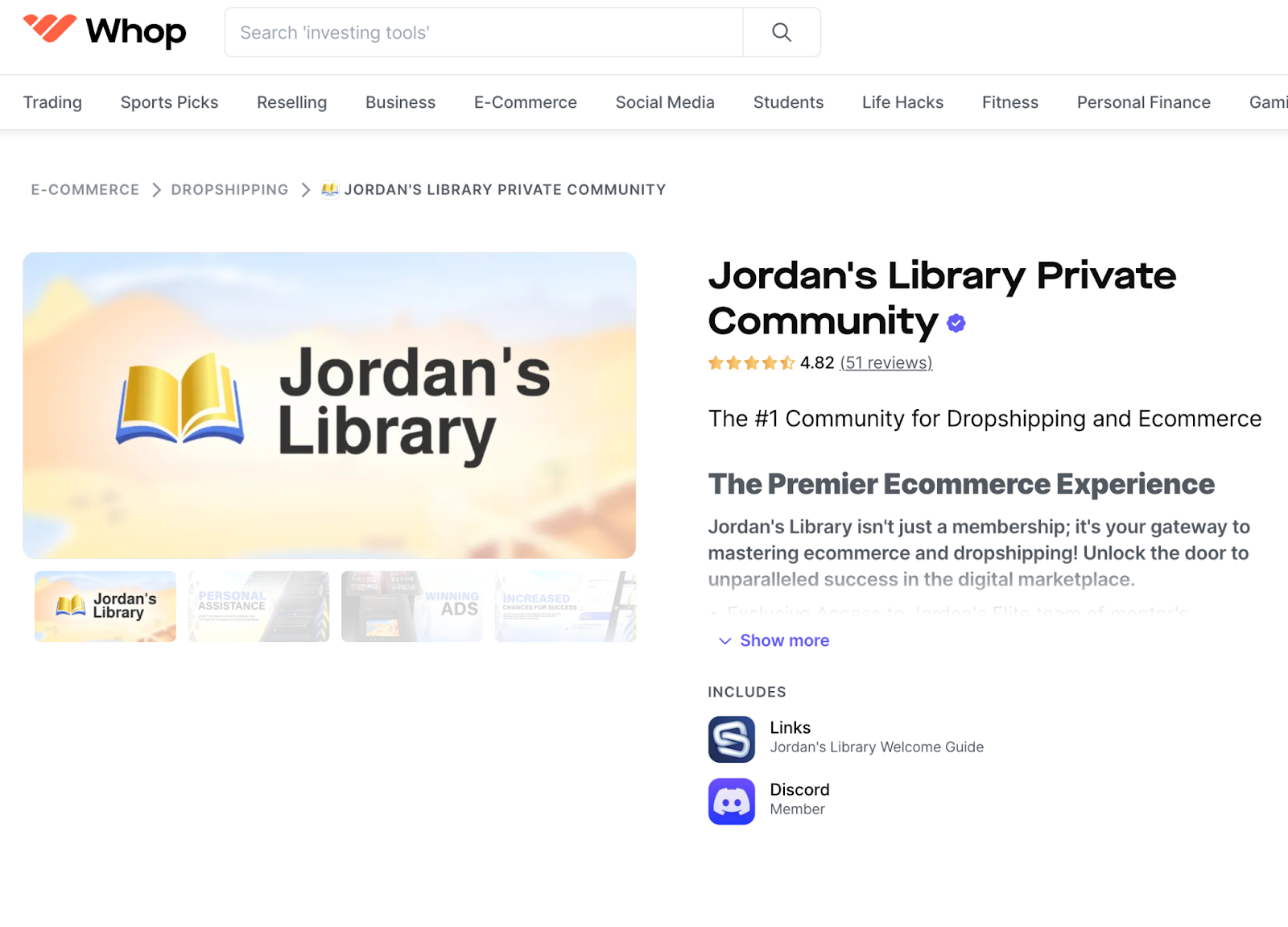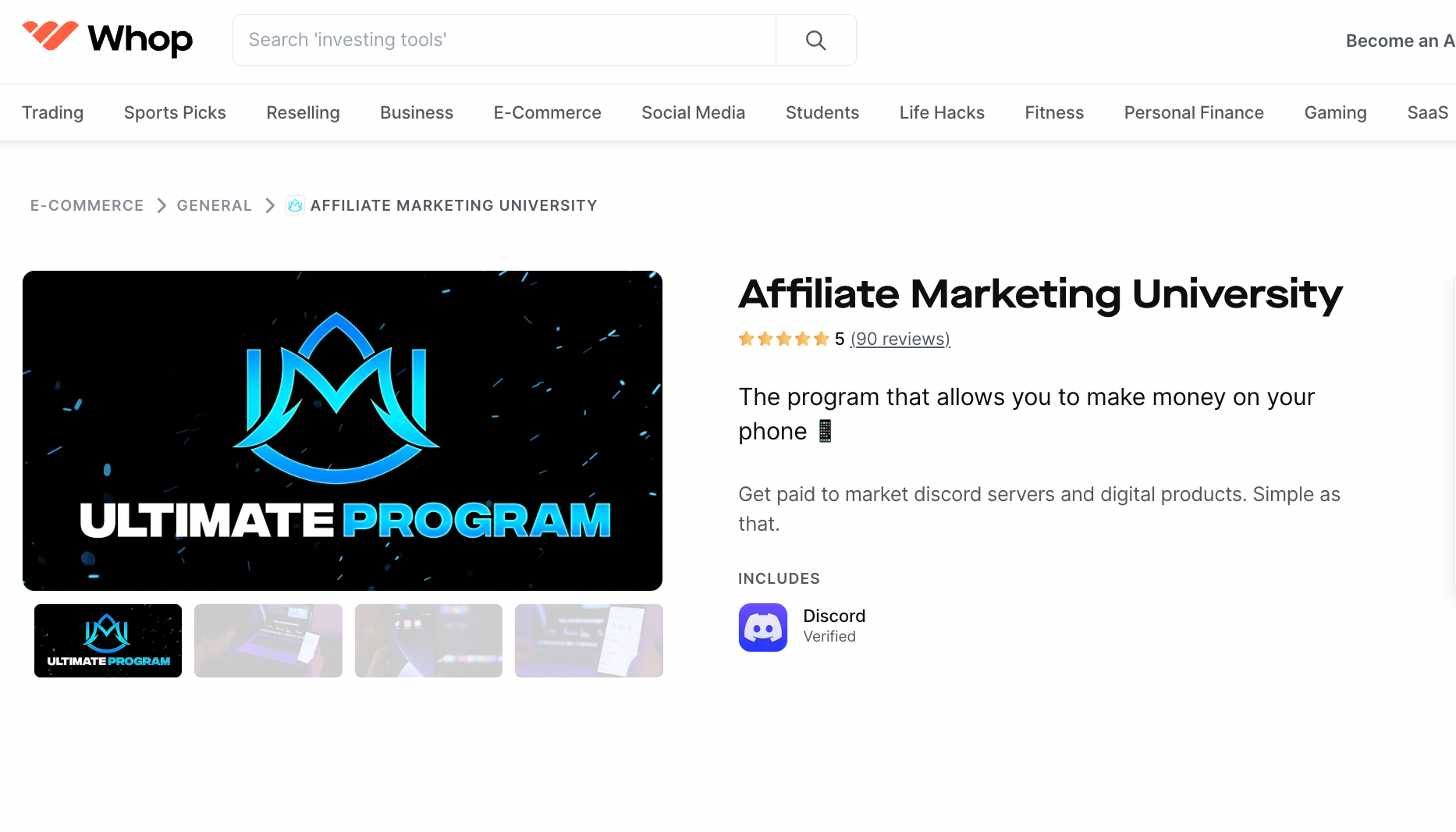Among all the trendy topics in the “make money online” discourse, two rise to the top - dropshipping and affiliate marketing. These are some of the original online businesses to start minting millionaires, for those who know how to make the most of them.
Both business models require experience in branding and design, paid advertising, and business operations. But, is one better than the other?
In this guide we’re going to cover what dropshipping and affiliate marketing are, what’s good and bad about them, and how you can start to learn the basics of them and start making money online.
What is Dropshipping?

Dropshipping is selling a supplier’s product as your own through a website. It involves finding a winning product, identifying a good supplier partner, creating a branded website and creatives, and then running paid marketing campaigns to generate visitors to your website.
Dropshipping is selling someone else’s product as your own.
With dropshipping, you don’t need to develop the product yourself (although you could) or worry about fulfilling the orders out of your own warehouse. That’s one of the biggest advantages of the business model.
Pros and Cons of Dropshipping
Dropshipping Pros
- Ability to Be Creative
Dropshipping in many ways is like building a completely new brand. Even though you don’t create a product from scratch. (Although, if you wanted to, you could do that with the right shipping partner.)
From the start, you’re finding a product that has a high potential of success. There isn’t just one product that will work, so you have a choice to make. From there, you get to create the logo, site, and the ad creative.
So aside from managing the warehouse and product itself, you have free reign to build a brand that you like. - No Inventory or Fulfillment
The main advantage for people who want to live the digital nomad lifestyle, or those who simply don’t want to go into an office everyday, is that with dropshipping you don’t package and send out the boxes yourself.
Your supplier is in charge of delivering the final product to the customer. Now, this has a drawback because it can take a while to finally get to the customer, but all in all most people find this to be incredibly incentivizing as managing a warehouse staff can be tough work that requires a lot of energy and time. - Can Change Course Quickly
If your product isn’t hitting quite as well as you had hoped, there’s really nothing stopping you from trying something new. Sure, you spent time building the website and creating a logo, but the main point is that you won’t have lost a ton of money tied up in inventory.
If your current store isn’t working, simply try a new product. - Building a Sellable Asset
Because you own the brand identity, the domain, and have access to all the customer data with dropshipping, you’re building something that could be sold. Typically, the type of company that would buy your store—a private equity firm or larger conglomerate—would need to see that your business has been running profitably for several years in addition to many other positive metrics, but the potential is there.
If you build a store that is producing quality profits, you have your customers’ data, and are able to retain them, you have something that could potentially be sold at a multiple.
Dropshipping Cons
- Highly Competitive
If you think dropshipping sounds good to be true, that may be the case, but the number of other people trying to cash in on the model makes it extremely competitive. Some of the best brand builders, media buyers, and internet business specialists are dropshippers for a reason.
Dropshipping can return massive amounts of profit, but the pure number of others doing it makes supply very high. - Ads Cost Money
Even though you don’t have to buy the inventory upfront, you will have to spend money on ads to acquire customers. And ads aren’t cheap, especially on Facebook, the go-to platform for ecommerce brands.
Historically, ecommerce brands used Facebook as an arbitrage opportunity to acquire customers for less than the money they made from them. Today, that’s not as much the case.
Ad costs have skyrocketed, making it harder for even the most experienced media buyers to find new customers at a reasonable price. The more brands that are buying ads on Facebook, the more expensive CPMs become. Supply and demand. - Lots of Testing
In the same vein, finding winning dropshipping products requires a lot of testing, which simply means that you’re going to have to spend more money on ads to find angles that work. You could brand a product in hundreds of ways. Perhaps it’s geared towards children, or women, or parents—each target customer will have a different brand identity.
Landing pages and copy also need to be refined. So in order for a dropshipping site to really take off, it require a lot of time and attention to find the right combination of creative and copy. - Long Lead Times
One thing that detracts a lot of visitors from shopping at a particular store is the time it takes to ship the purchase. Amazon Prime’s two-day shipping hasn’t made it any easier. Because products that are dropshipped typically come from China, it often takes seven to 14 days for them to get to the customer. This means less sales because customers don’t want to wait that long when they could get the same item from Amazon in just a few days.
What is Affiliate Marketing?

Affiliate marketing is similar to dropshipping in that you don't handle product or inventory, but requires more communication, relationships, and overall business acumen. To help explain it a bit further, there are a few key terms that you should be aware of:
- Commission: The amount of money that you as the affiliate get paid for every conversion or lead that you generate.
- Offer: This is the campaign, product, or service that you are marketing. This is essentially the same as the physical product you would sell with dropshipping.
- Advertiser: The person or company that “owns” the offer and sets the guidelines for the campaign and commission terms.
Affiliate marketing, simply meaning “word of mouth,” is when you find an offer and promote it through paid ads, organic SEO traffic, or social media.
Affiliate marketing is promoting someone else’s products or brand.
The campaigns that you would promote are found on platforms called affiliate networks. These are fully developed websites that host brands’ offers, give you links that track your conversions, let you get in touch with the companies you want to promote, and more.
If you want to get started in affiliate marketing, that requires signing up for an affiliate network, identifying the campaigns you want to promote, and agreeing to terms with the people who own the offer (the advertiser).
Pros and Cons of Affiliate Marketing
Affiliate Marketing Pros
- Unlimited Options
Affiliate networks are the places where you can find the campaigns and products that you want to promote. There are different networks that specialize in certain categories, for example, there are networks for gadgets, supplements, and more.
Because you’re finding the offers on these networks, versus choosing a random product on AliExpress, you have a ton of options from products that have been proven to sell. If there’s an offer—whether it’s insurance or foam pillows—you can find it. - Support Teams
Most affiliate networks will have a team of affiliate managers that are there to assist affiliates in getting set up on new campaigns and measuring results. These managers typically have access to winning ad creatives, landing pages, and angles that work for ads.
When you’re running an affiliate offer, it’s more like working with a team compared with dropshipping, where you have to manage everything from the marketing side and your supplier manages the fulfillment side. - Fast Experience
Spending your own money on a campaign that you choose is going to help you gain knowledge very quickly. You will be working with a brand or product that has likely performed well in the past, so their team will be able to help you, in addition to your affiliate manager.
So because you can choose from any number of campaigns and you can even run multiple campaigns at a time if you so choose, you’re basically getting decades of experience from different experts in just a few weeks or months. - Ability to Scale
Affiliate marketing has almost unlimited scaling potential. The brands that tap into the affiliate networks will usually have a long operating history. This means that they have their product figured out, their shipping and logistics dialed in, and they know how to interact with their customers.
For example, you could be an affiliate for a brand that does $50 million in revenue so you won’t need to worry about a lot of the headaches that come with running a business, or you could start from zero and build your own brand and figure out all of the operations. - No Customer Support
Similar to the above, as an affiliate you don’t have to interact with customers after they have made a purchase. Once you drive a visitor to the website, it’s the brand’s job to convert them, send them their product or fulfill the service, and respond to any inquiries. If your specialty is in paid media, then you’ll appreciate the lack of operational requirements.
Affiliate Marketing Cons
- Payment Schedule
When you’re running an affiliate offer, you're not the one getting paid directly. It’s going to the brand and then the brand pays the affiliate network, who eventually pays you. Payment schedules will vary by network. Some pay every week, others pay once a month, it just depends.
But, either way, your cash is held up for at least a few times which could make scaling campaigns harder. - High Risk
Affiliate marketing isn’t a guaranteed way to make money online. There is a tremendous amount of risk involved. Your campaign could be a flop, the advertiser could go out of business—anything could happen. One potential outcome is that you simply spend a lot of money trying to crack an offer, and it just doesn’t happen. In a sense, it’s almost like gambling as there’s no guarantee of the money finding its way back to you. - Lack of Control
Because you’re marketing someone else’s product, there are going to be rules that you need to play by. You can’t say anything that you want or create any ad that you like.
The more established and well-known the brand is, the more terms and conditions there will be. Additionally, you don’t have control over the customer data—that belongs to the advertiser. So if you wanted to remarket to those customers, it wouldn’t be as seamless as it would be if they were checking out on your website. - Bad Advertiser Relationships
Things inevitably happen when running affiliate campaigns, and these could damage your relationship with the advertiser. No affiliate-advertiser relationship is perfect, but you could find yourself in a situation where you lose a lot of money and time if things happen to go poorly. Hope for the best, plan for the worst. - No Equity Value
Finally, affiliate marketing isn’t a good way to build equity value. Traditional affiliate offers typically generate good profits for a few months, maybe a few years. So if you’re looking to build a business that you can sell, affiliate marketing isn’t the best way to do that.
There are some verticals, such as pay-per-call, that are good for building equity value, but those are few and far between and require extremely experienced affiliates and a comprehensive infrastructure.
Affiliate Marketing vs Dropshipping: Which is Best for You?
Let's start with a quick glance overview of the pros and cons of both dropshipping and affiliate marketing, then take a look at what you need to get started with both.
| Pros | Cons | |
|---|---|---|
| Dropshipping | You can be creative | It's highly competitive |
| No inventory management | Ads can be expensive | |
| Easy to pivot | A lot of testing needed | |
| Can eventually sell the business | Products take 1-2 weeks for delivery | |
| Affiliate Marketing | Unlimited options to promote | Payments are not consistent |
| Quickly gain experience< | Can be risky | |
| Can scale infinitely | No business to sell | |
| Dedicated managers to support you | Relationships with managers can be difficult to navigate |
Easiest to Start
Both affiliate marketing and dropshipping have low barriers to entry, but in different ways.
With affiliate marketing, you don't need to set up an ecommerce store. You simply need some sort of digital presence - whether that is a paid newsletter, social media profiles, or blog. Of course, the more digital footprint you have, the larger your audience and potential customer base.
However, when it comes to dropshipping, you do need to have an ecommerce store set up, whether its a full online store on Shopify or shoppable products on Instagram or TikTok shop. Plus, while you don't manufacture the products, you do have to choose the right products to sell.
So, affiliate marketing has a slight advantage in terms of barrier to entry, but you do need a decent-sized audience to make good money with it.
Required Investment
When starting any business it is crucial to know exactly how much money you need to invest to get started. Let's start with affiliate marketing. The main expenses you need to get started will be advertising tools, domain registration, and potentially website hosting. As for dropshipping, you will need to set up and maintain your website, and also manage advertising.
Therefore, both business options have a similar amount of financial investment needed.
Skillset Needed
Regardless of whether you are dropshipping or affiliate marketing you need to know how to build, maintain, and engage an audience. You typically need to understand SEO, social media, and paid advertising campaigns to be successful with affiliate marketing and dropshipping. Marketing is a key skill for these business avenues.
For affiliate marketers, you should know how to write high-performing engaging content that you can use across blog posts, newsletters, social media posts, and product reviews. You want your audience to trust your word and purchase based on your recommendation, so it has to be convincing!
For dropshippers, you need a more complex skillset. As well as marketing, you also need to know how to do product research and also how to take care of your customers. A key to success in dropshipping is finding the most profitable products to sell online.
Learn Dropshipping and Affiliate Marketing on Whop!
Dropshipping and affiliate marketing are two business models that are simple on the surface but require a lot of skills and knowledge to be successful in. Whichever route you choose to go down (maybe you even want to try both!), you need to know how to run your business.
The best way to learn isn’t always by doing because that could be costly, but by learning from experienced coaches who have made money from these operations before.
At Whop, we have dozens of courses and coaching programs that can help you go from a new founder to a successful business owner.


For example, Jordan’s Library is taught by seven-figure entrepreneur Jordan Brown and has an exclusive community with mentors, extensive training documents, and more, teaching entrepreneurs everything they need to know about ecommerce and dropshipping. Meanwhile, Affiliate Marketing University teaches its community the strategies and products needed to succeed with affiliate marketing.
Whatever money-making route you choose, Whop has all of the education, information, resources and support that you need to make it happen. Knowledge is power, so learn from the best and pave your way to success!
Why You Should Trust Us
Joe Niehaus is an experienced ecommerce specialist who has been in the affiliate marketing space for several years. He helped manage the affiliate programs for nine-figure brands and has also worked with top affiliate publishers like Business Insider and Travel + Leisure. His writing is the result of years of real-world experience.
Dropshipping and Affiliate Marketing FAQs
Answers to some of the biggest questions around dropshipping and affiliate marketing.
What is More Profitable, Dropshipping or Affiliate Marketing?
There isn’t necessarily one model that’s more profitable than the other. Both businesses can generate massive amounts of revenue for entrepreneurs who put in the work, have extensive experience, and choose the right products. However, both models can be risky and cause you to lose money if you don’t apply the correct techniques.
What Is EPC in Affiliate Marketing?
EPC in affiliate marketing is “earnings per click.” It’s calculated by dividing the amount of money you take in commissions by the number of clicks you generate. It’s the most important metric when judging the viability of a campaign.
How to Start Dropshipping for Free?
In today’s market, it’s not possible to start dropshipping for absolutely nothing. Even if you’re not running ads, you’ll still have to pay for a web hosting subscription. If you’re looking to start dropshipping, but don’t have any money to invest, consider trying TikTok Shop with TikTok Mastery on Whop.


![40 Easy Ways to Make Money Online [2024]](/blog/content/images/size/w600/2023/11/20-ways-to-make-money-online--1-.webp)


